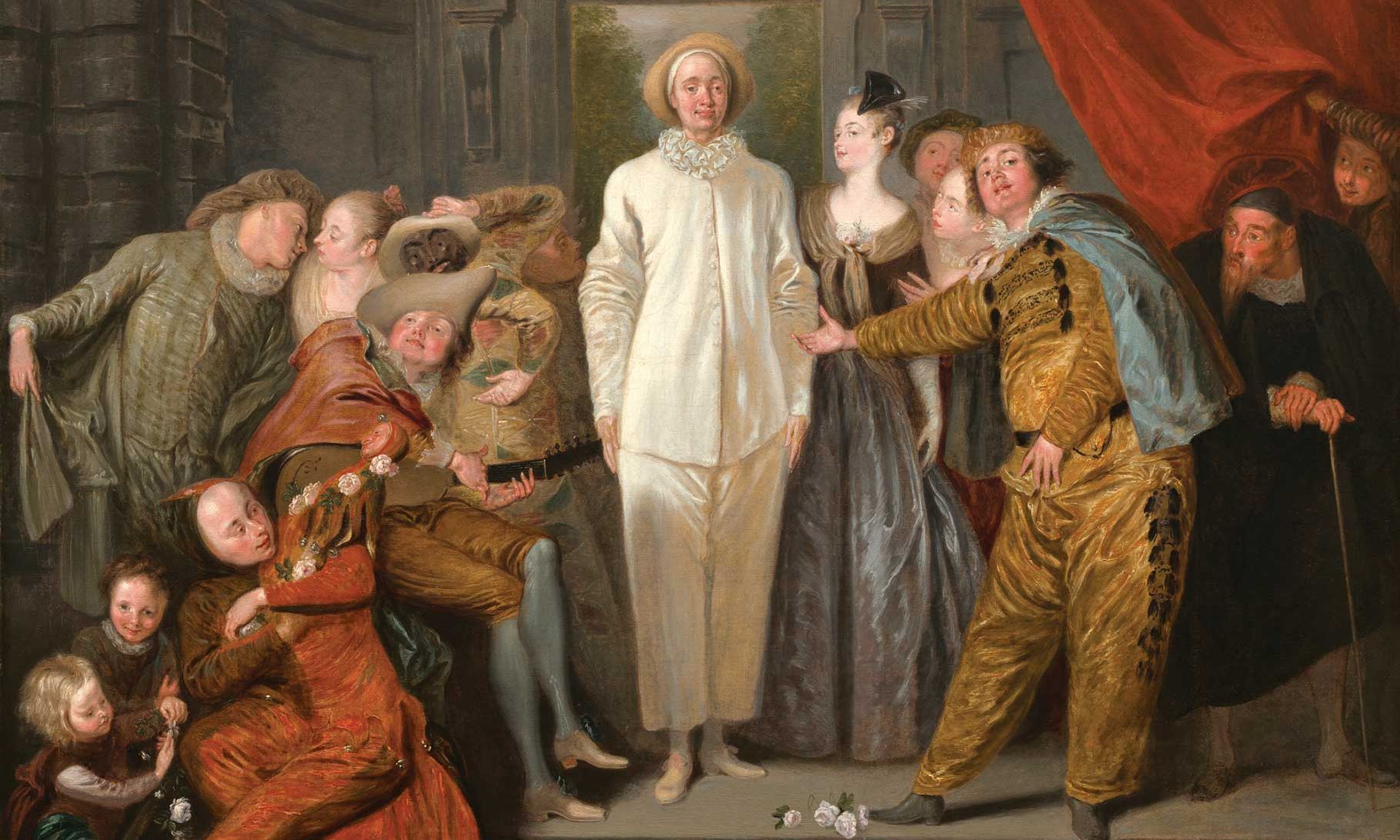Jean-Antoine Watteau’s The Italian Comedians (probably 1720) has Pierrot, dressed in white, at its centre. An earlier work by Watteau, The Departure of the Italian Comedians, describes the expulsion of commedia dell’arte performers from Paris
Courtesy National Gallery of Art, Washington
In 1697, Louis XIV expelled France’s official company of commedia dell’arte performers from Paris. Jean-Antoine Watteau’s painting of The Departure of the Italian Comedians imagined a crowd gathering to watch the banished actors’ despairing histrionics. Indeed, by the time of his picture’s probable date in the 1710s, the city’s commedia dell’arte tradition had taken stealthy root outside. Companies of “Italian” actors, featuring the familiar stock characters of Columbine, Mezzetin and Polichinelle, regularly entertained audiences of idlers, walkers and shoppers at improvised theatres in the city’s fairs: the Foire Saint-Laurent, in Paris’s north-eastern corner, and the Foire Saint-Germain, a fabric market on the south bank that had expanded, in the words of Marika Knowles—a senior lecturer in art history at the University of St Andrews—into “a ritzy venue for shopping, entertainment, and the promenade”.
An increasingly prominent figure at these performances, typically dressed in white linen fastened with oversized buttons, was Pierrot, the commedia’s clumsy buffoon. Pierrot’s tenacity, and ultimate rise to ubiquity in French porcelain, print, photography and film, is the subject of Knowles’s monograph, which runs from the 18th-century fairs through the 19th-century bric-à-brac markets up to Marcel Carné’s poetic realist masterpiece Les Enfants du Paradis, filmed during the German occupation of France in 1945. Despite its broad historical scope, Knowles’s book is not a general critical history of Pierrot in the vein of Robert Storey’s 1978 precedent, Pierrot: A Cultural History of a Mask. Rather, it is interested in how this bumbling rustic’s stock quality of awkward disjointedness reflected 18th- and 19th-century ways of thinking about developing marketplaces. This includes both literal markets of clothes, bric-à-brac and art, and more figurative marketplaces of “human personae”.
Knowles is in firm command of her wide-ranging material, but she seems most at home with Watteau. Her discussion will be of particular interest to scholars working on this artist, not least for its substantial discussion of his monumental Pierrot (around 1720), now in the Louvre. Watteau’s clown smiles enigmatically (or foolishly?), at what seems to be a curtain call, or perhaps one of the small skits (known as “parades”) with which fair companies attempted to drum up a paying public. In either case, it is certainly an address to the commercial world around him. This is not a new idea; the picture’s sense of solicitation led the art historian and curator Hélène Adhémar to suggest that it was intended as a promotional signboard for the popular Pierrot Belloni, who had recently hung up his own white linen and straw hat to open a café. This suggestion is now rather unpopular and Knowles makes short work of it, highlighting instead how Pierrot’s “frontality” intersects with Watteau’s interest in character and costume prints, a genre that developed in the 17th-century Netherlands with a clear eye on expanding middle-class markets. Drawing on the recent work of Sarah R. Cohen, Knowles offers an illuminating account of this genre, whose distinctive solitary figures are (like Pierrot) untethered by narrative or context. When writing on Watteau, and particularly his relationship to the fair, it is difficult to avoid Thomas E. Crow’s seminal Painters and Public Life in Eighteenth-century Paris (1985), which covers much of the same material. Knowles’s contribution is her insistence on Pierrot’s status as a figure inherently untethered, always available, and therefore uniquely marketable.
In the first decades of the 19th century, Pierrot was supposedly discovered by Vivant Denon—writer, art dealer and first Louvre director—in a curiosity shop. In an often sharp, though slightly meandering, chapter, Knowles brings the “market for old things” that permeated post-Revolutionary Paris to a reading of Manet’s Old Musician (1862), which reimagines Watteau’s figure as a street-smart gamin in dirty clothes, part of a group of itinerant and vagabond Parisian “types” drawn from French and Spanish art history. Though Manet alludes directly to Watteau, by the mid-19th century Pierrot had gained new status thanks to the work of Jean-Gaspard (“Baptiste”) Deburau, a spectacular mime and acrobatic artist who personified him in a sculptural white ensemble with a black skull cap at the Funambules Theatre, drawing the attention of bohemians such as Gérard de Nerval and Théophile Gautier.
Deburau ultimately furnished the inspiration for the central character in Carné’s Les Enfants du Paradis. By this point, Knowles suggests, Pierrot’s “whiteness” had been established as the epitome of French Classicism, and his innocence and gullibility conflated with an ugly strain of antisemitism and nationalistic nostalgia. Her discussion of this film is fascinating, though it is difficult to trace the overriding significance of the marketplace motif here, except insofar as Carné’s Pierrot (played by Jean-Louis Barrault) is imagined as an art-for-art’s-sake idealist. Indeed, Knowles’s theme is not always wholly convincing as a single unifying through-line on Pierrot, who emerges from this otherwise engaging book as a figure altogether too pervasive and chimerical to be neatly pinned down.
• Marika Takanishi Knowles, Pierrot and his world: Art, theatricality, and the marketplace in France, 1697-1945, Manchester University Press, 264pp, 64 b&w and 16 colour illustrations, £85 (hb), published 9 January 2024
• Kirsten Tambling is a writer and academic in London, specialising in the 18th century. She has recently written a book on royals collecting Shakespeareana

